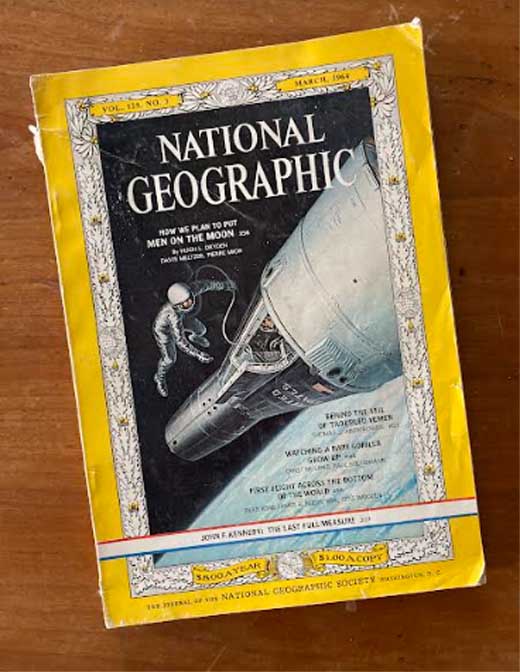
In the late winter of 1963-64, the National Geographic Magazine published its March 1964 issue. The cover story described America’s efforts to reach the Moon by the end of the decade, an almost overwhelming project that was initiated by President Kennedy, just months after his inauguration in January 1961. But the magazine also carried its own tribute to the late President, who had been assassinated the previous November in Dallas. The story was called “The Last Full Measure,” and was written by its president and editor, Melvin Bell Grosvenor. He began…
His life was such — the radiance he shed — that if we live to be a hundred, we will remember how he graced this earth, and how he left it. Only the future can assign to John Fitzgerald Kennedy his true place in history, But this I know. When men now boys are old, in distant time beyond the year 2000, they will say, ‘I remember I remember when they brought him home, the murdered President, from Dallas…’
Again and again the story will be told — just as I recall my Grandfather Grosvenor, at 92 telling me graphically of how, as a young student at Amherst College in Massachusetts , he traveled by horse and train to the bier of the martyred Lincoln.
I still have that copy of the National Geographic. I keep it on a shelf of books and artifacts — touchstones from my life. Meaningful to me, but few others. I still remember reading and pausing after those first lines —”when men, now boys…remember.” I had just become a teenager and I looked years younger. But I realized he was talking about me…about my generation of Baby Boomers. I had never considered the insane reality that someday, far into the future, we would become old. The idea that I might live in a world beyond the Millennium seemed impossible. I somehow assumed I’d never live long enough to write “2000” on a check, or in a journal. The 21st Century was so far away. My life was just beginning…
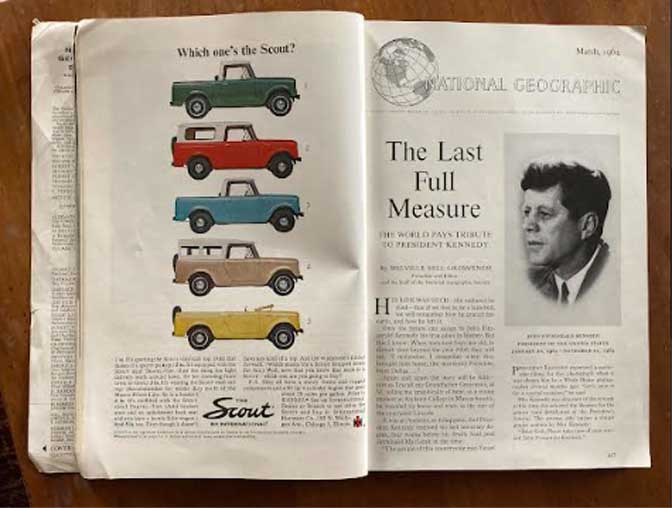
And then, I blinked. And I was here.
Last night I came across a new three part series, also presented by National Geographic, about the JFK assassination. The program offered no new insights into John Kennedy’s murder, but it was attempting to tell the story to new generations of Americans who have no memory of that Friday afternoon in November 1963, or the days, weeks, months, and even years that followed.
And it added one sobering reminder. The series had sought to find and interview “the last surviving witnesses” of the fatal shooting in Dealey Plaza. There were very few; I have been a “student” of the assassination for most of the last six decades, I was at one time a first tier conspiracy buff. I visited Dallas several times over the years, stood behind the picket fence on the “Grassy Knoll.” I’ve been to the Sixth Floor museum. I’ve read scores of books on the topic, poured through the 26 volumes of the Warren Report, watched countless programs with wildly differing theories.
Thirty years ago, I found a small classified ad in the back pages of Rolling Stone magazine. It offered for sale a virtual library of audio and video tapes of the media coverage on that weekend. I paid $250 for six VHS videotapes that contained 36 hours of continuous live coverage of the shooting. In the fall of 1963, the ABC affiliate in Dallas, WFAA, had purchased its first videotape machine and a healthy stockpile of two inch videotape.
In the decades that have passed since then, my views on the shooting have evolved. New technology allowed researchers to re-examine much of the evidence. Finally after years of speculation, I concluded that the conspiracists were wrong — some more wrong than others. And that Lee Harvey Oswald, this “wretched waif of a man,” as author William Manchester described him, had changed the course of history.
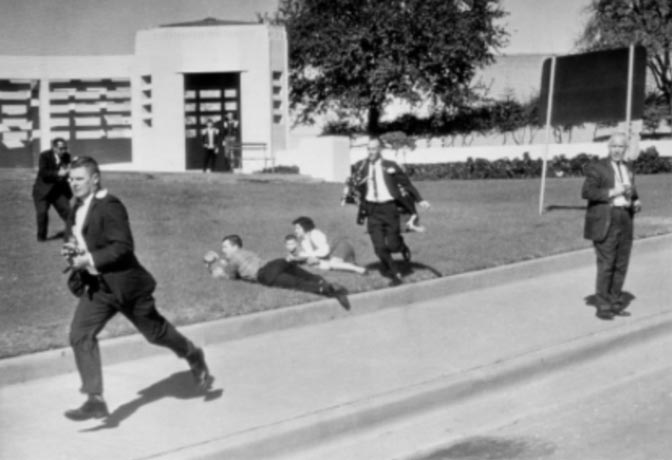
I recall the first witnesses to the assassination to be interviewed on live television, though I only saw the interviews years later, on the WFAA videotape. Bill and Gail Newman were brought to the studio by the managing editor at WFAA,, and put them on camera within 15 minutes of the last shot. Watson himself had only been a block away, when he heard the gunfire, He ran to the edge of Dealey Plaza and saw the Newmans lying on the grass, by the curb on Elm Street. They had thrown their own bodies on their two children, fearing more gunfire.
A few minutes later, local dressmaker Abraham Zapruder appeared on camera as well. He mentioned that he “had film” of the assassination. No one would guess, at that moment, that Zapruder’s 8mm movie would become the most famous and disturbing amateur film in history.
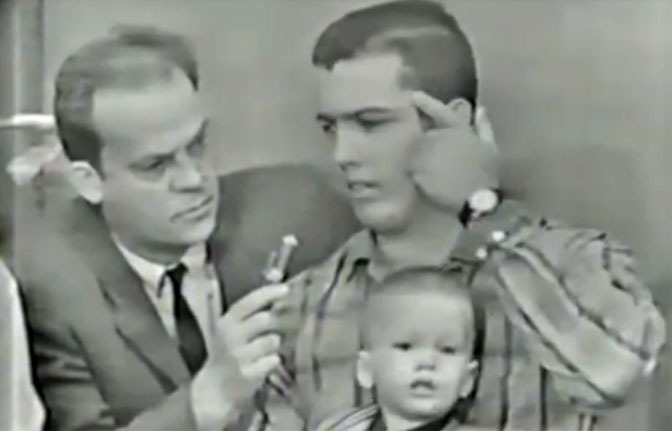
The Newmans were only 22 years old that day. Their two boys were two and four. Now the Newmans are in their 80s and their two boys are past middle age. They were participants in the 60 Year Remembrance.
The program interviewed Sid Davis, one of the last reporters who covered the assassination. Davis had covered the presidency since 1961 and now, he struggled to close his report of the day’s tragedy, after the long flight back to Washington. Searching for the right words, he turned to Robert Frost. Davis noted that President Kennedy was especially fond of Frost and often pulled a quote from his favorite poet as he traveled around the country. Now Davis cited from memory…
“…But I have promises to keep, and miles to go before I sleep. And miles to go before I sleep.” As he signed off, “This is Sid Davis at the White House, his voice cracked ad he broke down. On this day, even hard-edged reporters could not hide their feelings.
The producers of the new documentary also spoke at length with Clint Hill, the Secret Service agent, who tried in vain to reach the presidential limousine from the SS follow up vehicle. He reached the rear bumper just 1.2 seconds after President Kennedy was hit by the fatal shot. The image of him reaching for Mrs. Kennedy, and captured on the Zapruder film, as the First Lady climbed frantically over the trunk, is one of the most heartbreaking images of our time.
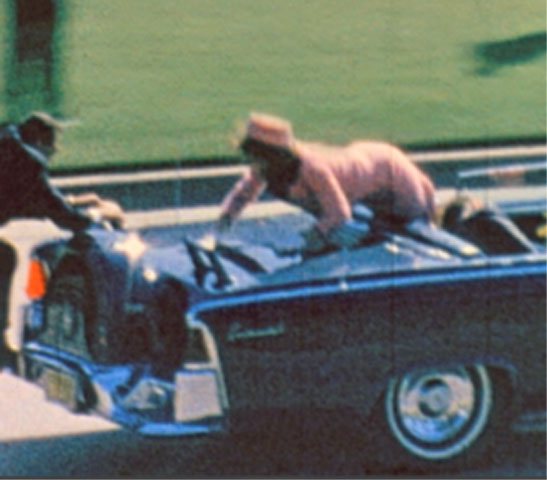
They raced to Parkland Hospital and reached the ER in five minutes. But for JFK, it was too late. Clint Hill had thrown his body across the back of the limo, assuming that more shots were to follow, and that if anything, he could save the life of the First Lady. He had seen the damage done to the President’s head, and knew it was a mortal wound. For decades Hill suffered from alcoholism and, to this day, blames himself for not reaching the president sooner.
Both Sid Davis and Clint Hill are now in their nineties. Hill is the only survivor of those who were in the limousine after the last shot.
Both Governor Connally, who survived his wounds, and Mrs. Connally are gone. So are the Secret Service agents, Bill Greer and Roy Kellerman. Greer, the driver of the limo, would be haunted for years that he didn’t react more quickly to the first shot.
Jacqueline Kennedy died in 1993, six years before the death of her only son.
It had not occurred to me, but it was true. In the very near future, only a handful of children who were on Elm Street that day will have any memory of one of the most seminal moments in American history.
The 60th anniversary of 11.22.63 is significant and the world takes note of this anniversary. By the time we reach the next milestone — the 75th anniversary — hardly a living soul on this planet will still be alive to provide their own memories. The day will be left to historians and to the latest conspiracy theories. The Reality and the Myth of John Kennedy will reach far into the future.
****
Of course, all the books and videos and movies and documentaries and the conspiracy theories would come later. On that Friday afternoon, the country and its citizens, for once, shared a common sense of grief and outrage. I remember that day. I even remember that morning. And though my own recollections of the Kennedy assassination carry no weight or historical significance in the greater scheme of things, I record these memories mostly for myself. And for some of my fellow Boomers who also remember, and wonder how we got from there to here…wherever ‘here’ is in 2023….in the relative blink of the eye. I can still feel what it was like, and I still look back on the assassination with sadness and bewilderment and, for me, even a certain amount of shame.
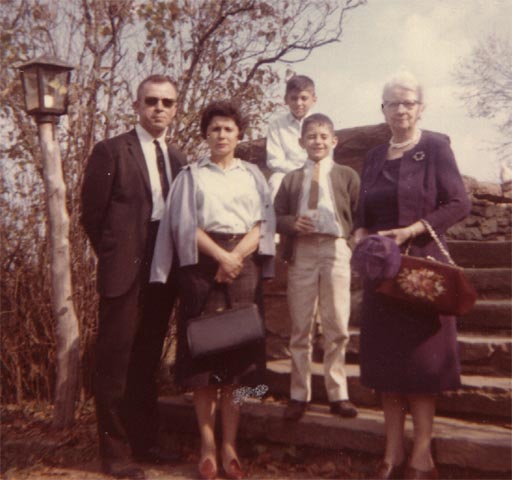
I grew up in a virulently Republican home. My dad wasn’t a far right conservative; he opposed the John Birch Society and other Far Right Wing political groups. But he had no use for Liberals either. He especially feared the Kennedy Family and what he claimed was the beginning of a Dynasty that would somehow overtake and destroy America. Even as a 12 year old, I found myself puzzled by his intense animosity against JFK. I’d ask him to explain just what it was he had done that created such angst, but my father’s answers were always vague.
He had admired JFK for his handling of the Cuban Missile Crisis in October 1962. Flashing back to a year earlier, I can remember those 13 days clearly. My father was convinced we faced nuclear war, especially after JFK’s nationally televised speech to the country. The Russians had placed “intermediate range nuclear-armed ballistic missiles” on the island of Cuba. JFK, on the night he addressed the nation, warned of the consequences if they were not removed. I was playing in the basement with a friend, when my father called me upstairs to watch the speech. Kennedy talked about a “full retaliatory response against the Soviet Union,” if the missiles were not removed immediately. He wanted me to see the speech. It was “history in the making,” he said. My father looked genuinely scared.
The next morning, I noticed that he had placed a large wooden box full of canned goods and other necessary supplies by the kitchen back door. Then he took me into my bedroom and asked me to rehang all my clothes so that the open end of the coat hangers faced inward. Why? I asked. He said, “That way, you can pull a few clothes directly from the closet and take them with us.”
“Where are we going?” I asked. He was evasive, but later I found a Texaco road map in the box and he had marked out an “escape route,” apparently in the event of nuclear war. He had highlighted back roads that would carry us to the edge of our county and beyond…hopefully beyond the immediate flash of an atomic bomb. A week later, the crisis was resolved diplomatically and the box of goods disappeared.
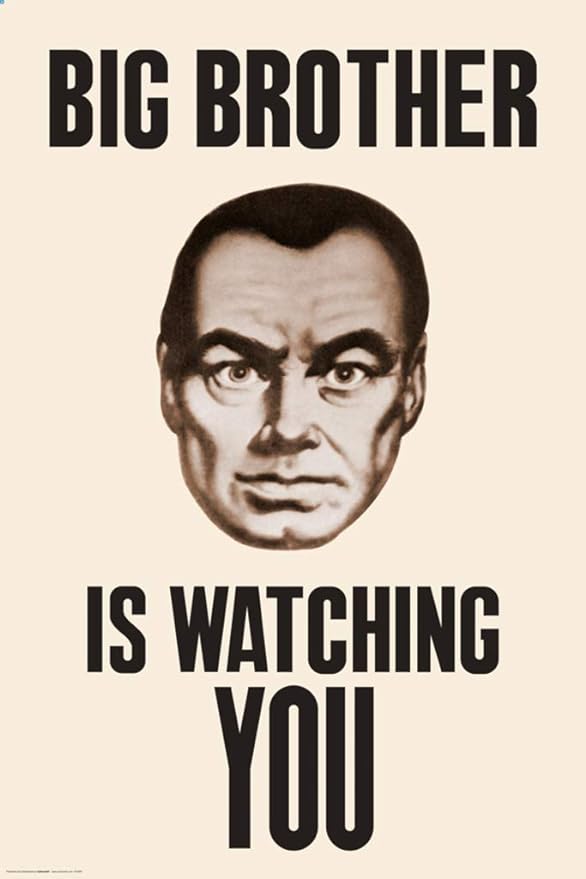
Now a year later, my father had seemed to forget JFK’s handling of the crisis. I look back on that time and though I don’t have a 24/7 memory of everything that occurred 60 years ago, my brain still contains little vignettes of that time. A week before the assassination, on the night of November 15, 1963, my dad and I stayed up late to watch the film “1984,” by George Orwell. It was a 1955 cinematic version of the book, and starred Edmund O’Brien. We stayed up until almost 1 AM, and I admit that even as a kid, the film was chilling. As the movie ended and we were turning off lights to go to bed, my father said casually, but grimly, “I want you to remember that movie, because this is exactly what is going to happen to our country if the Kennedys stay in power.”
I was my father’s son. It would be another couple years before I finally broke away from him and form my own values and beliefs, and began to realize that my father was not infallible, and that his irrational fears were unfounded. But on this night, as we stumbled up the stairs, I took his every word to heart. I still feel embarrassed and a bit ashamed that I could not see his concerns through clearer eyes. But I was twelve. Later I would read a quote, by JFK himself. His father, Joseph Kennedy, had been the ambassador to Great Britain at the beginning of World War II. Joseph Kennedy was an isolationist who came dangerously close to supporting an appeasement attitude toward Hitler. Years later, when a reporter asked Kennedy about his father’s political position, Kennedy shook his head ruefully and shrugged, “Well…we all have fathers, don’t we.” I knew exactly what he meant…
I knew that JFK was in Texas, though I barely took note. On Thursday evening, there had been a short news report on the Texas trip. In Houston, Kennedy addressed an enthusiastic crowd and noted the recent contracts awarded to the state for the development of NASA facilities in Houston for the Apollo moon program. He said that the development of the Saturn V rocket would create the “biggest payroll…uh…payload in history.” He was commenting on the rocket thrust of the Saturn, but then paused and smiled, “…and it will be the largest payroll in history.” Lucrative contracts were going to Texas and other states where the 1964 election could be close. Then as now, politics has not changed much in 60 years.
November 22, 1963…Friday
But the next morning, I had already forgotten the speech. That fall, my mother dropped me off at my new school. Every morning I dreaded the short drive. I’d even plead with her to go slower. It was a bleak gray morning in Louisville. We took a back alley called Speed Avenue. I have one snapshot memory of that moment. Just the gloominess of the day, the dull flat gray sky, and recalling how, when I stepped out of the car, I was already dreading another day at Highland Junior High School.
The morning passed. Routine. I remember little of it. But during the sixth period, I was in Miss Zilhart’s French 1 class. She was an old woman, at the end of her teaching career and showed little interest in her work. But at 2: 37 PM, we heard the overhead intercom crackle to life. We heard someone blow on the microphone, just to be sure it was working. Then we heard the voice of our principal, Mr. Stevenson. I can remember his words almost precisely…
“Faculty and students, I have some terrible news, this afternoon, our president was killed…”
Before he could finish the sentence, an image formed in my head. It all took less than a second. But for that split moment, I assumed he was talking about the Student Council president, a boy my age named Tom Norman. I thought, ‘how could he be dead?’ For the briefest of moments — milliseconds — I imagined that Tom had fallen down those cold marble steps at both ends of the school, and that somehow he had hit his head and died. I was able to divert from what was coming for just a moment. Then Mr. Stevenson continued…
“…President Kennedy was shot during a motorcade in Downtown Dallas, Texas. He died at 2 PM Eastern Standard Time. There are reports that the Texas governor has been shot as well. I will keep you informed of more details, but we should all take a moment of silence to pray for President Kennedy, his family, and for our country.”
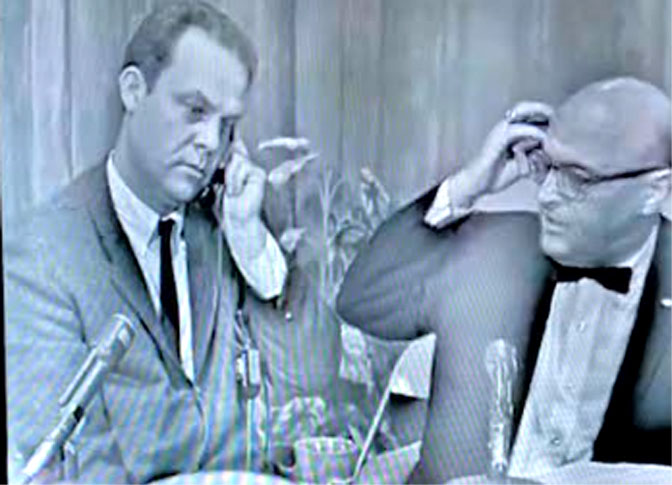
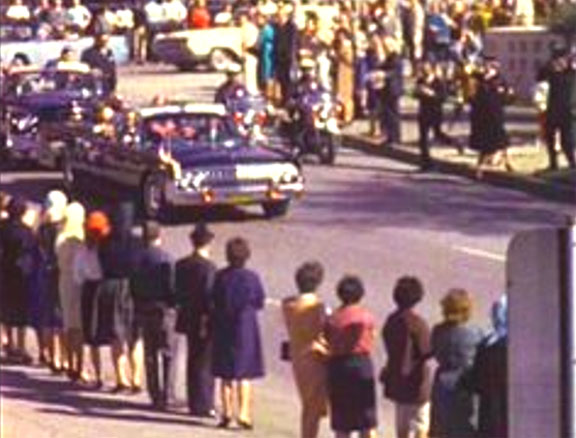
The room was dead silent. We students looked at each other, but could not speak. Miss Zilhart somehow tried to continue the lesson; she was almost incoherent as she tried to explain the conjugation of some French word, or expression. Then as she faced the blackboard, she suddenly dropped her chalk and turned to the class.
“This is awful…we cannot learn any more today.”
She sat down at her desk and said nothing. The 3 o’clock bell rang. The school day was over. I ran outside and looked for my ride home. That autumn, the mother of a neighbor gave all of us who lived on that street a lift. There were two girls, my age, who were already in the car, sobbing uncontrollably. They could not stop crying. I sat there silently. I was thinking of what my father had said, just a week before. At a time like this, how could I be speculating on the long term consequences of JFK’s murder? Thinking back to the week before and “1984,” I even thought, ‘could this be the act that saves the country? Is my father right?‘ It would be years before I felt downright shame, a certain disgust with myself that I still feel now, that I could have even conjured such a despicable notion.
Our homes were only a five minute drive. I jumped out of the car and ran to the front door. My mother opened it, and tears were streaming down her face. I was genuinely shocked. Their antipathy toward JFK had been so intense, I was surprised to see her show any emotion at all. . I ran upstairs to the tv and turned to the NBC affiliate in Louisville. WAVE-TV.
(Twenty five years later, I would obtain all the NBC tapes of that afternoon. I was able to pinpoint the precise moment when I turned to the news. Reporter Frank McGee said, “…we now take you to the United Nations.” The Secretary General U Thant offered a brief statement, then asked the General Assembly to rise for a moment of silence, in honor of President Kennedy.”)
As the afternoon moved on and nightfall approached, reports from Dallas had begun to suggest that a possible suspect had been captured at a local movie theater. At first the man had been arrested for the shooting of a Dallas policeman, JD Tippit. There was nothing to indicate that this could also be the man involved in murdering President Kennedy, and still it struck me as odd that the media was already seeing a connection. Later, it became more apparent. The manager of the Texas School Book Depository had done a head count of his employees and had told police officers that one man was missing — His name was Lee Harvey Oswald.
The chief of detectives, Will Fritz, turned to one of his officers and told them to pick up this man named Oswald. The officer turned to Fritz and said, “I can save you the trouble…there he sits.” They must have all been dumbstruck, as was the rest of the nation, by the bewildering coincidence. That night, almost 100% of the country believed the police had captured the killer. It would be months or years before questions would be asked about Oswald and his involvement in the assassination.
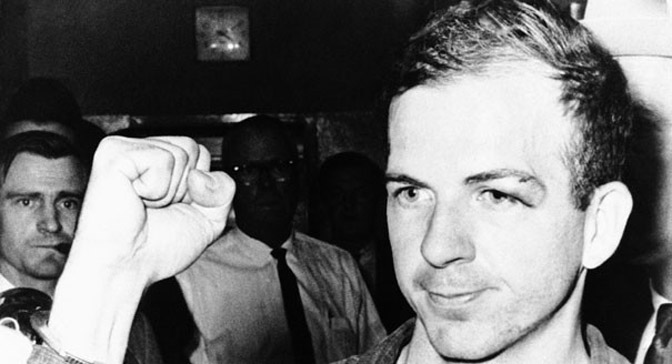
*****
At about 4 PM, my father called. My brother and I were both glued to the television, to NBC. Chet Huntley, David Brinkley, Frank McGee and Bill Ryan continued to report the wildly unfolding events of that day. A rookie NBC reporter, Robert McNeil, was in Dallas and in the motorcade. It was McNeil who would report the official word via pay phone at Parkland. It all happened so quickly — JFK shot. Kennedy is dead. A suspect has been picked up in Oak Cliff for the murder of a policeman. Already by the late afternoon, news that Oswald was a Marxist who had defected to Russia, only to return to the United States two years later with a Russian bride. Until that moment, the national consensus assumed that the shooter was a Right Wing fanatic.
My father briefly mentioned the shooting, then asked my mother if I had finished my chores as he had instructed me that morning. He wanted me to rake up all the leaves in the front yard. I had completely forgotten, but my father had not. My mother came into the tv room and said, “Your father wants you to get out there and rake the leaves. He told you to do this when he left for work.”
I said, “Mom! The President has been murdered.” For once she relented…a little. She said, “Well go outside and at least do a little, so he’ll know you made the effort.”
I put on a jacket and went outside. I pushed leaves for a few minutes, then gave up. I told my mother I would just have to pay the consequences, but I was going back to the tv and the news reports.
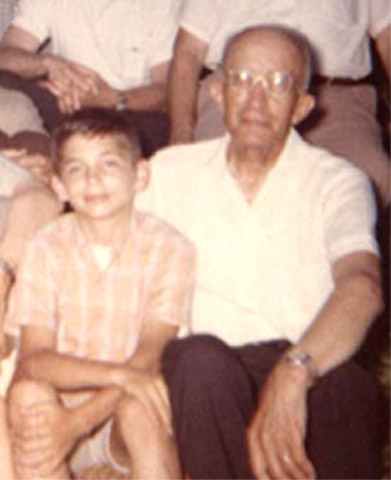
My father was home by 5 PM. If he noticed I had failed my chores, he didn’t say anything. Maybe he understood more than I gave him credit for. Besides, it had already been planned that we would have supper with my Grandparents — my mother’s mother and father. It was a short drive to their home at 216 N. Birchwood in the Crescent Hill section of Louisville. When we walked in, the tv was on. My grandfather’s eyes were moist. My grandmother had the food on the table and we sat down to eat. But I remember the silence. No one spoke. None of us. My grandfather, whose stern face always betrayed one of the kindest hearts I have ever known, said nothing. My father tried to initiate a conversation. None of us could talk.
Then, at 6:05 PM, with the television still on, just a few feet away, I heard Frank McGee suddenly interrupt Frank Ryan and say, “…to Andrews Air Force Base! Live!”
It had to be one of the saddest and most surreal live news broadcasts in history. As Air Force One came to a stop in front of the terminal, brilliant klieg lights were turned on, illuminating the aircraft. The backdoor of the 707 opened and we could see familiar faces from the Kennedy Administration in the doorway. En route to Washington, a hydraulic lift truck was requested to
expedite the removal of JFK’s casket from the plane. In Dallas, the secret service had struggled to get the casket up the stairs and had even broken the handles on the bronze casket in the process.
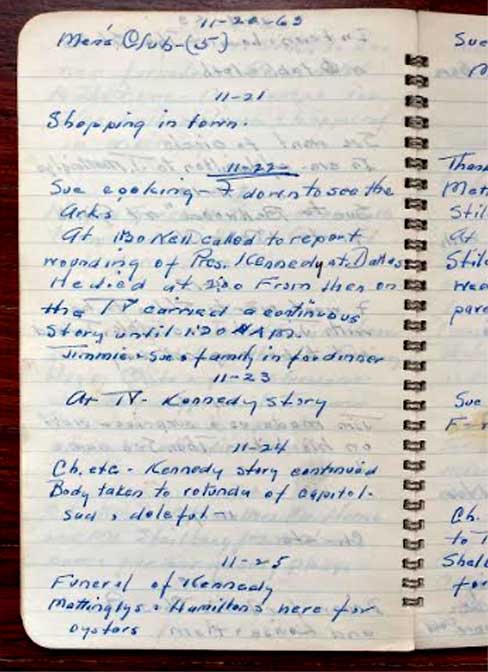
The hydraulic truck backed up to the AF One door. For a moment we could see nothing. Then images and harsh shadows, cast by the television lights revealed men coming forward onto the truck. They were clearly struggling to move the casket. Finally we could see the bronze coffin.
Standing beside it were the men who had been closest to him during his presidency. The hydraulic lift was finally lowered. Other civilian men and the military honor guard rushed to the casket to move it to a nearby ambulance. At times the coffin wobbled sickeningly as these men, some much older than the president, struggled to lift it. But the military honor guard quickly took over and JFK’s body was transferred.
Then, for the first time, Jacqueline Kennedy appeared in the open truck. Beside her, inexplicably, was Bobby Kennedy. We wondered why or how he was there. RFK had not been in Dallas or on the flight home. Later we learned that the moment AF One stopped, he raced up the front stairway of the plane and ran its length to be with Jackie. Newsmen reported that he simply said to her, “I’m here.”
Jackie and Bobby and the remainder of the staff exited from that hydraulic truck. Then, as the First Lady emerged from the crowd and into the bright lights and television cameras. We could see her just briefly as she stood at the edge of the truck. She was helped off the truck and she walked to the ambulance. She attempted to open the back door but it was locked. Clint Hill ran to the driver and told him to open it. And there was something different about her. In those days, all television was in black and white. But my brother and I could both see dark stains on her skirt and even darker streaks on her stockings. She had been so impeccably dressed, just
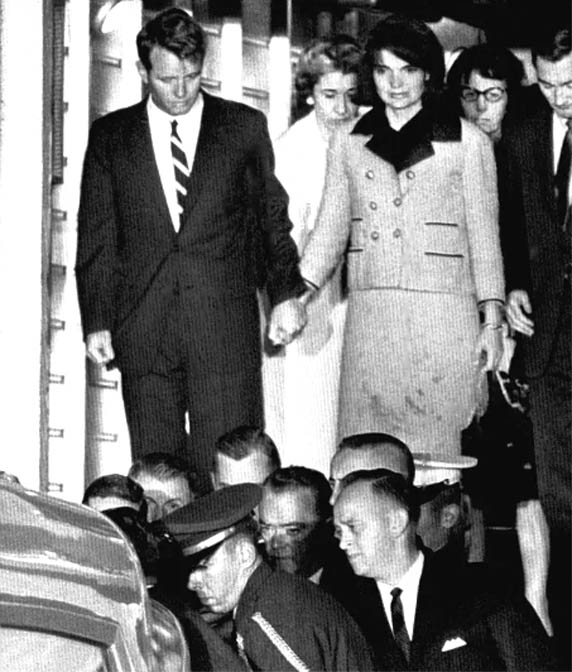
five hours earlier. I said, “Is that blood on her?” No one could speak. Kennedy’s body was taken to Bethesda Naval Hospital. LBJ and his wife Lady Bird were greeted by a phalanx of congressmen and cabinet officers. But finally President Johnson broke from the small cluster of men and walked to a microphone. He said:
“This is a sad time for all people. I am sure the world shares the sorrow that Mrs. Kennedy and her family bears. For me, it is a deep personal tragedy…I will do my best. That is all that I can do. I ask for your help…and God’s.”
I know the quote from memory. And I add it here because I recall another conscious thought that flashed through my head at that moment. For me, LBJ has always possessed the most annoying and twangy Texas accent. But now, as he spoke, I thought, ‘he sounds different. No twang at all.’ His voice seemed to carry more weight than it ever had before. Later, I would hear recordings of his remarks, and realized he had sounded no different than any other speech he had ever given. Maybe in that moment, I was trying to assure myself that the tall Texan, whose boss had just been murdered in LBJ’s home state, was up for the job.
Johnson walked away from the microphones and he boarded a military helicopter for the White House. Ten minutes later, the press was there to record his exit from Marine One, and with his key advisors with him, walked toward the White House. To his credit, we later learned that the Johnsons didn’t move into the White House residence for another month, to give the former First Lady time to deal with her children and the abrupt and brutal reimagining of their lives.
At 8 PM my family hugged my grandparents and we drove home. I stayed up until NBC went off the air. Here is the video of Frank McGee, signing off for the evening. “November 22nd…Into the history books, marked by the blackness of this day and deed.”
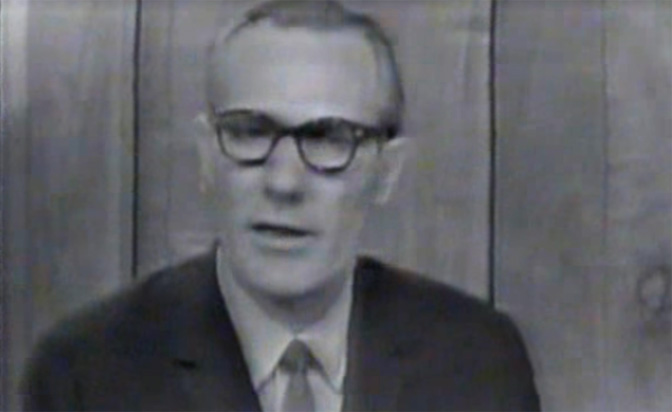
those last two minutes of the NBC coverage.
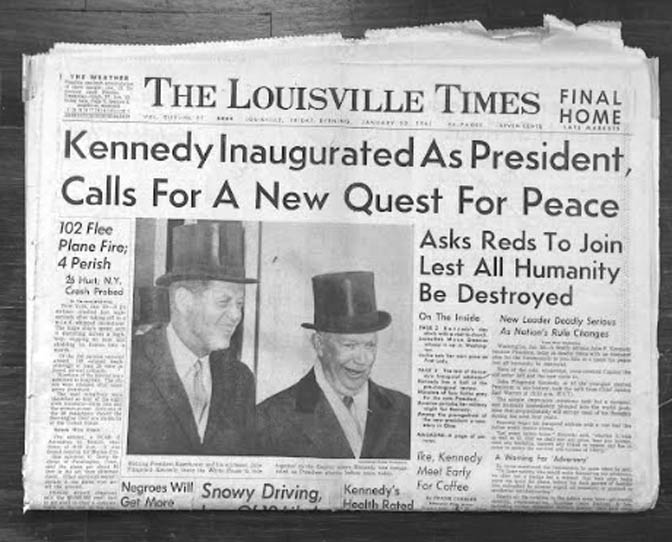
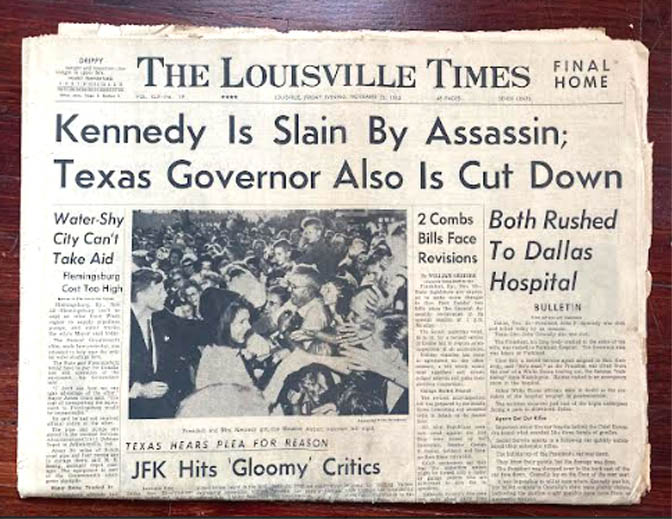
November 23, 1963 Saturday.
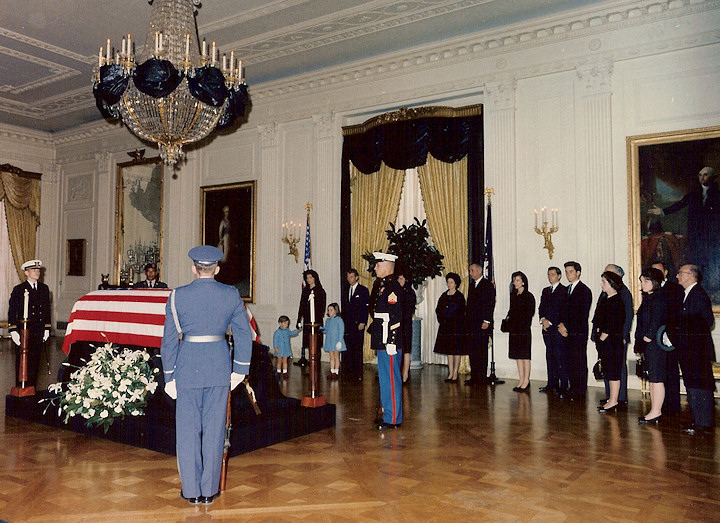
I awoke to the sounds of a drenching rain. The skies could not have been darker. The rain persisted, hard and heavy, all through the day. This is the day I recall the least. I stayed inside and watched the news.
All morning and into the afternoon, the networks broadcast the arrival at the White House of Congressmen and Senators, Supreme Court Justices, Cabinet members and other government officials. They had been invited to view Kennedy’s flag-draped casket in the East Room of the White House. There were no JFK adversaries on this day. Twenty five years later, one of the honor guards who stood at one of the four corners of the casket, recalled a particularly poignant moment. During a brief service, the Marine was faced toward the congregation of official mourners. And he saw that Governor George Wallace, the segregationist governor from Alabama, was sitting beside the Chief Justice Earl Warren. It had been The Supreme Court’s “Brown versus the Board of Education” ruling that ended segregation in public schools. No one more virulently opposed the ruling than the Alabama governor, and had stood briefly in the admissions doorway to the University of Alabama, honoring his proclamation, “Segregation now. Segregation tomorrow. Segregation forever.” Yet now the two men, who came from opposite ends of the ideological spectrum, spoke quietly to each other. Both men were crying.
(NOTE: In 2023, could this still happen?)
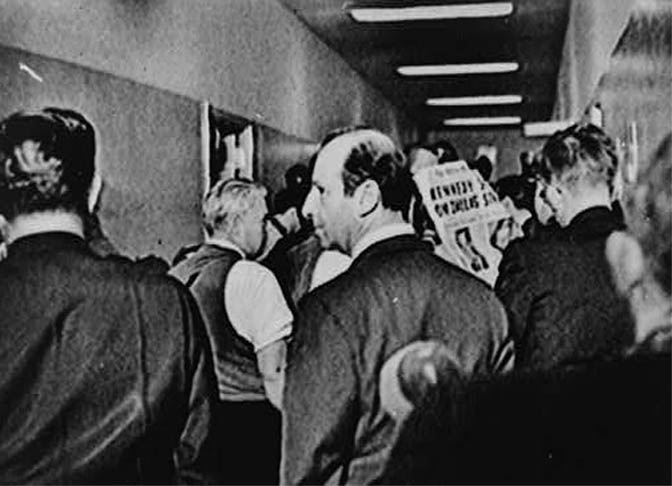
In the evening, the networks often cut to Dallas, where hundreds of reporters from all over the country and the world had descended on the Dallas police station. It was utter chaos. Oswald was paraded before the press, news cameras, and even the big bulky tv cameras of 1963 had been moved to the third floor of the station.
Occasionally Oswald was moved down the hallway to another room and he shouted out denials to the audience he had always wanted. He held up his handcuffed fists in defiance. Among the spectators that night was a man who had no business being there. He wasn’t a cop or in the FBI or the media. His name was Jack Ruby. He owned a nightclub in Dallas and was handing out cards to the reporters, promising them free drinks at his strip joint when “all this is over.”
Of course, none of this was reported that night. Few knew who he was. But the Dallas Police did; he was what they called a “cop wannabe.” He was down there frequently. Images of him viewed later even revealed the outline of a snub-nose .38 on his waist belt. No one noticed and if they had, the cops would have thought nothing of it. They knew Ruby always carried a gun. It was 1963. As one sheriff deputy said later, “Back then, all business owners carried personal protection. Jack was no different.”
The day ended. The rain stopped and that Saturday evening, the stars came out.
November 24, 1963… Sunday.
We always went to church on Sunday mornings. My father insisted we go to the early service at 8:30 AM and so my brother and I dragged ourselves out of bed. We attended Buechel Methodist Church, just a stone’s throw from our first home on Glenmeade Road. The minister at the time was a man named Hugh Allen. He had recently succeeded our longtime minister Emil D. “Mac” McAdams, who was loved by the congregation. It was a hard act to follow.
Rev. Allen had the best of intentions, but he lacked Rev. Mac’s charisma. Allen had rewritten his sermon to reflect the events of Friday afternoon. He did his best. Then, at the very end of his sermon, he invoked JFK’s most memorable lines from his inauguration. But Rev. Hugh botched the last line and reversed the order. He said, “Ask not what you can do for your country. Ask what your country can do for you.” The congregation squirmed, Rev. Allen caught his mistake and corrected it. But he had lost the power of that moment. After the service, I could hear whispered comments as we filed out the door. Some were derisive; others more forgiving. To my father’s credit, he said, “Anyone can make a mistake.”
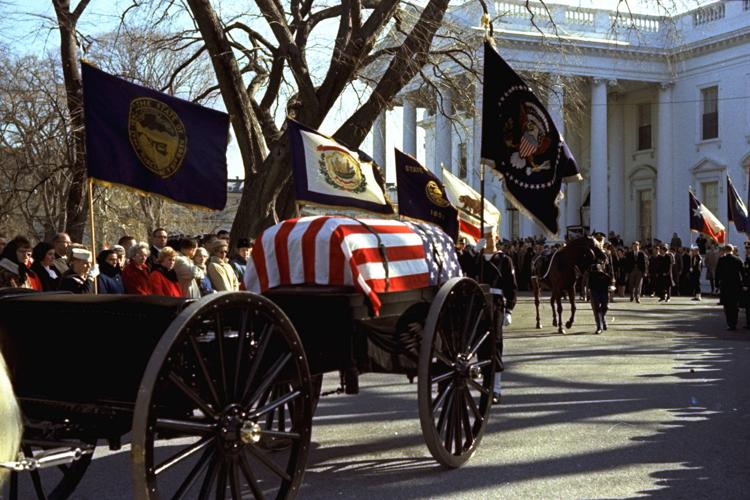
to lie in state at the Capitol. November 24, 1963.
When we got home, the procession to transfer President Kennedy’s body via horse drawn caisson, from the White House to the Capitol had just started. Just as the First Lady and her sweet little children emerged from the White House, my father said, “Turn that off. Let’s go for a drive. We need a break from this.” I reluctantly agreed, and we piled into our 1959 Chevy to take the backroads into the country. In fact, we followed the same “escape route” my dad had plotted for us a year before. We had taken the Billtown Road into Bullitt County and had crossed the old Rolling Fork River bridge. Dad said, “Okay…I guess we should head home. He turned the car around and we ascended the steep hill just north of the river bridge. I was sitting in the front seat and without permission, turned on the radio. It must have been about 12:22 PM EST. We could hear pandemonium coming though the speakers…
“OSWALD HAS BEEN SHOT! OSWALD HAS BEEN SHOT! There is absolute pandemonium here!”
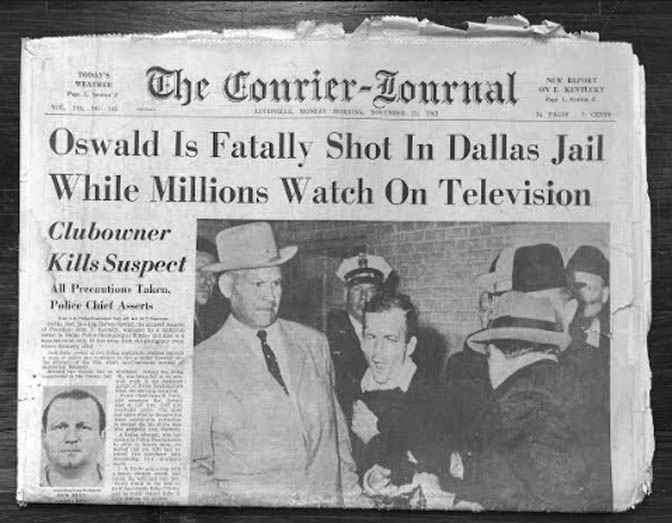
They would identify the shooter, Jack Ruby, within minutes. But upon hearing the news of Oswald’s mortal wounding, my father suddenly came unglued. He started pounding the dashboard with his closed fist and kept yelling, “GOOD! Let them all kill each other! Good!” He must have realized how unhinged he sounded, and stopped screaming. I don’t think he spoke another word all the way home.
I had no idea what he was talking about. I was utterly confused. Good? Let them all kill each other? What was he talking about? The 45 minute drive home passed in silence. But as soon we got back, I raced to the television. The networks were struggling to determine which story should receive priority coverage. The State Funeral had begun. Anyone who recalls the sounds of those muffled drums as the funeral cortege made its way up Pennsylvania Avenue to the Capitol, will never forget. It was majestic. Heartbreaking. Sad beyond expression.
But events in Dallas were unfolding as well, at breakneck speed. Only NBC had cut to the transfer of Lee Harvey Oswald from the city to the county jail, and had only made the decision 30 seconds before Ruby fired his .38. The other networks were taping however and immediately went back to Dallas to play the first murder ever committed on live television. For the rest of the afternoon, the networks tried to balance their coverage but it was impossible to call it ‘balanced.’
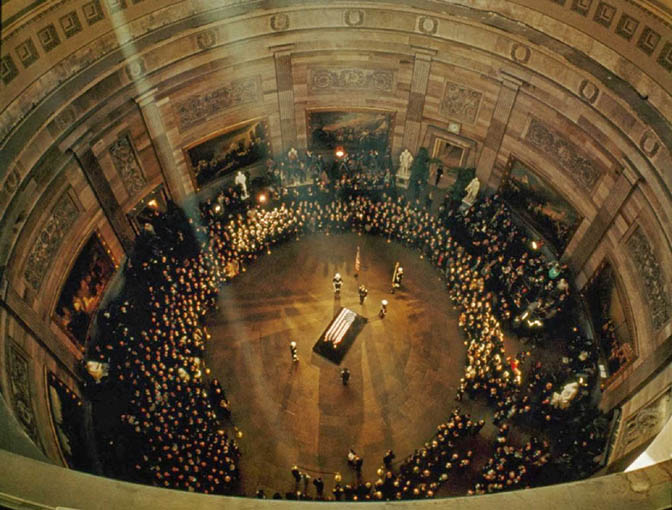
On one hand was the solemn, heart wrenching, yet elegant procession of the cortege, the carrying of the casket by the military honor guard to the capitol rotunda. Mrs. Kennedy, dressed in black and heavily veiled to conceal her swollen eyes, led her six year old daughter Caroline to the funeral bier and to the flag-draped casket. They knelt down and Mrs. Kennedy kissed the flag. Millions of Americans, across the country dissolved in tears.
But fifteen hundred miles to the Southwest, Oswald was rushed to a hospital…to Parkland Memorial Hospital, where the same surgeons who had tried to save the President, were now applying those same skills to save the life of the President’s alleged assassin. But they failed. Just past 1 PM, Oswald was pronounced dead. He had been wheeled to the adjoining Trauma Room #2 and died just 15 feet from Trauma Room #1, where the President had been pronounced dead, exactly 48 hours and seven minutes earlier. The announcement was made moments later on national television.
The country and the world felt as if it had just entered the realm of the surreal. Reporters asked themselves, ‘what will happen next?’ Many, including the new president, feared that very thing. President Johnson suspected a coup or an unprovoked sudden nuclear strike. Johnson may have known more, even then, than the rest of the country would learn almost 60 years later. He had reason to worry. (More on that aspect of the assassination at another time).
***
That evening, my family visited my paternal grandparents. The mood was somber, but not quite like the stoic sadness that my mother’s parents felt on Friday evening. We all sat in their big living room. There was an easy chair in the corner with an antique spinning wheel that my grandmother had owned for years. The wheel still had a crank and spun easily; and I sat there, idly spinning the wheel and listening to the conversation between my dad and his father, JFK had not yet been buried, but my father was already speculating about Kennedy’s death, his successor, Lyndon B. Johnson, and how it would affect the country. As mentioned, my father was no fan of the Kennedy Family.
My grandfather asked my dad specifically, how he felt about the assassination. I stopped spinning the wheel when my father replied, “Well…I would have rather beaten him at the polls, but I think it (the assassination) is good for the country.”
The conversation’s tone took a darker turn (if anything could be worse than that) and soon we headed home. Once again, I turned on the television, this time to CBS. And just as the screen flickered on, it seemed as if all hell had broken loose. Already by mid-afternoon on Sunday, local Dallas stations were reporting a rumor that Lee Oswald and Jack Ruby knew each other, and that Oswald had even been identified visiting Ruby’s strip club. Bob Walker, the local anchor at WFAA, the ABC affiliate, reported that, “there definitely appears to be a link between Oswald and the man accused of shooting him.”
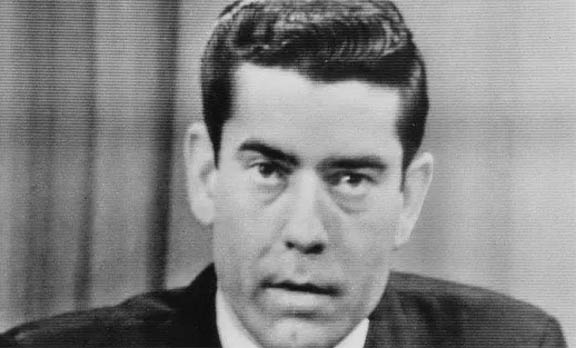
But now, on the rival CBS station, KRLD, Dan Rather, just a rookie reporter in 1963, who covered stories out of Texas, had grabbed the rumors and ran with them. I can still so vividly recall Rather talking to a couple of the exotic dancers who worked at the Carousel. He had brought both to the station to interview them. The women insisted they had seen Oswald at Ruby’s club. Rather could barely contain himself. He may have thought that he had the scoop of the century.
Then, he employed a television technique that was new to the medium. It had been developed for use in NFL football games, so that viewers could watch a particular play again. The era of “instant replay” had begun. Now Rather asked his technicians if the same technique could be used to watch the footage of Oswald, as he emerged from the police booking office into the underground parking lot. The plan had been to move him by armored car to the county jail, a process that was standard procedure. The video showed Oswald, being escorted by Lt. Jim Leavelle on his right, and detective LC Graves.
Rather asked, can we use instant replay here for the shooting? They could, and in the next minute, CBS played the event, almost one frame at a time. As Oswald approached the cluster of reporters and police, Oswald clearly turned his head to his left and stared at the people closest to him. Rather was sure Oswald had looked at Ruby and for a brief moment, appeared to recognize him. Then Oswald turned away, and a second later, Ruby leapt from the crowd and fired one shot at point blank range into his upper abdomen. Rather said, “Let’s play that again.”
And I had to agree, in slow motion, Oswald definitely appeared to recognize someone to his immediate left. Whether it was Ruby, or someone else, or he was simply staring at the reporters and photographers, who could say? But that night I remember going to bed, thinking the next week’s news events could be even more sinister and earth-shattering than the week we had just lived through.
November 25, 1963 Monday
It was a beautiful crisp late autumn morning. This was the day of John F. Kennedy’s funeral. Later he would be laid to rest at Arlington National Cemetery. Jackie Kennedy herself picked out the location on Saturday, during that driving rain. Among the small group of close friends who accompanied her were her two brothers-in-law and Robert McNamara, JFK’s Defense Secretary. The decision was made and preparations for his burial began. The general public knew little of the details at the time.
The First Lady had also insisted on an “Eternal Flame.” She had seen something similar in Paris, at the Arc de Triomphe, for the lost unknown soldiers of the First World War. She met heated opposition from her closest confidantes, insisting there was not time to create such a memorial in just one day. But she was adamant.
The remainder of that last day is like a montage of still images, wrapped in black crepe. The Honor Guard took the President’s casket back down those long capitol steps to the caisson, then back briefly to the White House. It may still be one of the most courageous act that the world’s leaders have ever displayed as one united group of grieving men and women. More than sixty of the world’s political leaders had come to the funeral. The First Lady insisted that she would walk behind her husband’s casket, from the White House to St. Matthews Cathedral and the funeral mass. Again, despite the intense resistance from the Secret Service, Mrs. Kennedy prevailed. She was followed by her brothers, President and Mrs. Johnson and scores of world leaders and public officials. There had never been such a tribute before, for any fallen president. It will probably never happen again.
After the Mass, the casket was again placed on the caisson for the longer ride to Arlington. As Mrs. Kennedy watched, she leaned down to her son, who was on this day celebrating his third birthday, and whispered something to him. John Kennedy, Jr took a step to his left and saluted his father. As Secret Service Agent Clint Hill would say later, “From generals on down, there were tear-filled eyes.”
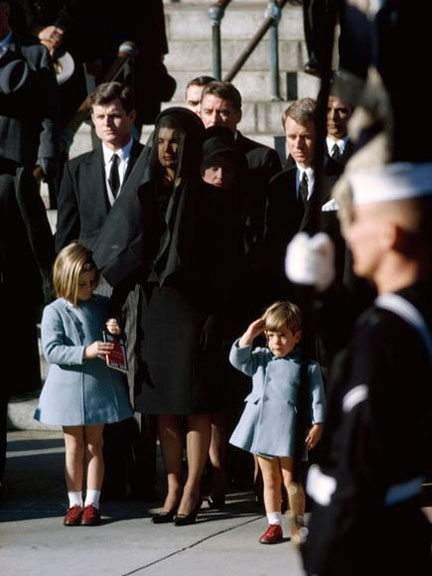
An hour later, it was over. The eternal flame had been finished in time. The First Lady lit the flame, and President Kennedy’s brothers touched the torch to the flame as well. A few words were offered by Cardinal Richard Cushing, the president’s lifelong friend from Boston. The flag over the casket was folded by the Honor Guard and presented to Mrs. Kennedy. She turned to leave and stumbled briefly but Robert Kennedy was there to catch her. Live television continued, focusing on the casket, but the networks killed the feed before it could be lowered into the earth. It was the right thing to do.
And suddenly, it was over.
November 26, 1963 … Tuesday
The next day Life was supposed to return to “normal,” but it never did.
Schools reopened. Millions of businesses across America opened their doors again. President Johnson addressed the nation before Congress on Wednesday evening. The next day was Thanksgiving. The official Christmas shopping season began the next morning, though nobody called it “Black Friday” then.
The next week, rumors about an Oswald/Ruby connection faded away. The dancers retracted their statements. Few believed that Oswald had recognized Ruby in the two seconds before Ruby killed him.
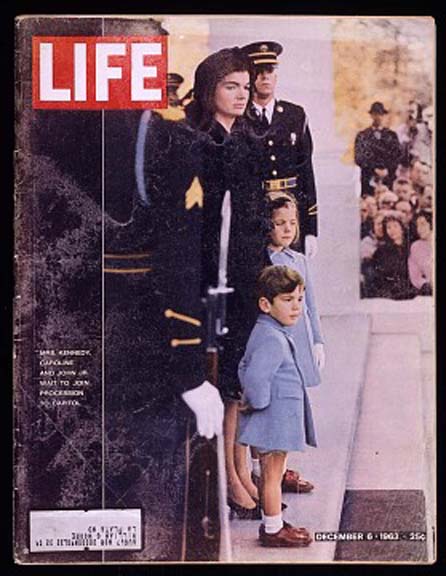
On December 2, LIFE magazine produced a special edition for the assassination. Late on November 22, an editor for LIFE had heard of the amateur 8mm film that Abraham Zapruder had shot in Dealey Plaza. Richard Stolley, on behalf of LIFE, offered Zapruder $150,000 for the exclusive rights to the 26 seconds of film that depicted in horrifying detail, the killing of President Kennedy. In addition, Zapruder insisted that they post only still images from the film that were not too graphic. Consequently, it would be years before those images ever made their way to the public eye.
When LIFE published more than 20 images from the Zapruder film, the magazine declared that the film categorically proved that one shooter assassinated the president. And while I’m now convinced they were ultimately correct, LIFE was right, but for all the wrong reasons. And today, I stand with a minority of Americans who reject the conspiracy theories.
The Zapruder film itself was not aired for 12 years, until Geraldo Rivera located a bootlegged copy and played it on an ABC program called “Goodnight America.” Seeing the moving images for the first time, more than a decade later, re-ignited the controversy and questions about second shooters and magic bullets and the Grassy Knoll. The debate continues to this day.
Then, just six weeks after Christmas, the Beatles made their American debut on the Ed Sullivan Show. It was February 9, 1964. Many, who still remember, think that Beatle Mania and the “British Invasion” that followed, was the release Americans, or at least the younger ones, needed to move on from November 22. In the months that followed, Americans did seem to be “moving on.” Lyndon Johnson was wildly popular and won a landslide election the following November.
But ultimately, we never moved on. Not really.
We had thought, or at least hoped, that the country would learn from this. That it might be a time for healing. A time to put aside differences and seek common ground. But it didn’t happen. Most of the readers of this story most likely know the long chain of historical events that followed — to a time that seems worse than ever. For me and for so many others of my generation, it feels like the world is truly falling apart. We lived through the assassinations, Vietnam, Watergate, race riots, and I don’t mean to diminish their importance, or the tragedy of them. And yet, until recently, I still maintained the dream that there was a way to change course. I rarely feel like that anymore.
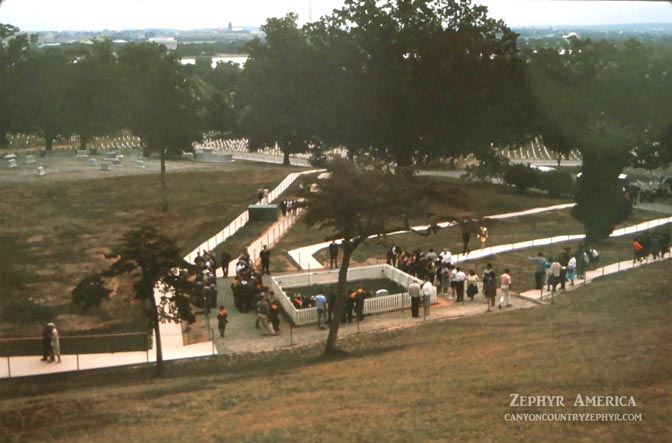
RETURNING TO DEALEY PLAZA & 11.22.63
A decade ago, I returned to Dallas and Dealey Plaza with Tonya (my former wife). She had heard me talk endlessly about the assassination, and I wanted her to see the site for herself. I had last been there in the 1990s. In some ways, the area is frozen in time. The live oak trees are bigger. The Grassy Knoll and the picket fence are intact, though pieces of the fence are constantly being removed by souvenir hunters. And much of the fence is covered with graffiti, most of it supporting conspiracies, especially those that implicate the U.S. Government.
All the buildings are still there, as they had been in 1963. For a while, in the 70s, there was serious talk of tearing down the Texas School Book Depository. The building itself was considered a stain on the City of Dallas. But cooler heads prevailed.
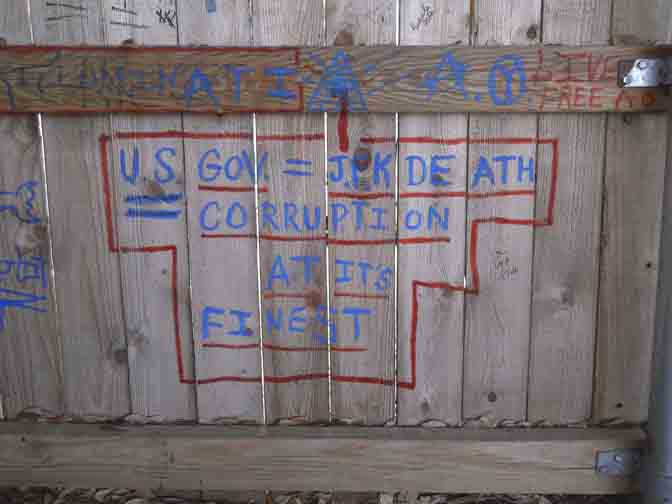
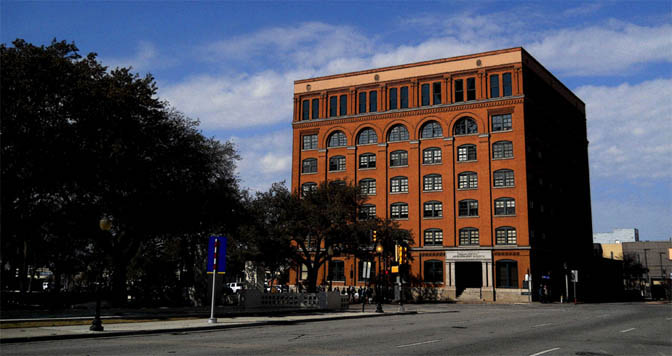
Photo by Jim Stiles
In the late 1980s, the Sixth Floor Museum was created. Some critics opposed the Museum, suggesting that it was commercializing one of the greatest tragedies in American history. Others, including me, believe that the Sixth Floor has more than redeemed itself since its opening.
It’s true, the sniper’s nest in the southeast corner of the Sixth Floor has been recreated, just as it was found that Friday afternoon, and protected by a floor-to-ceiling plexiglas wall. But since its opening, the museum has not only collected thousands of artifacts from that weekend, but has made a significant contribution to history via its oral history program. It has also hosted and produced many public presentations by historians, authors, and eyewitnesses. Last week, it featured an interview with Clint Hill, and conducted by author Gerald Posner, who wrote “Case Closed.” These presentations have become invaluable.
(NOTE: Dozens of these presentations can be found on YouTube and the Sixth Floor Museum channel)
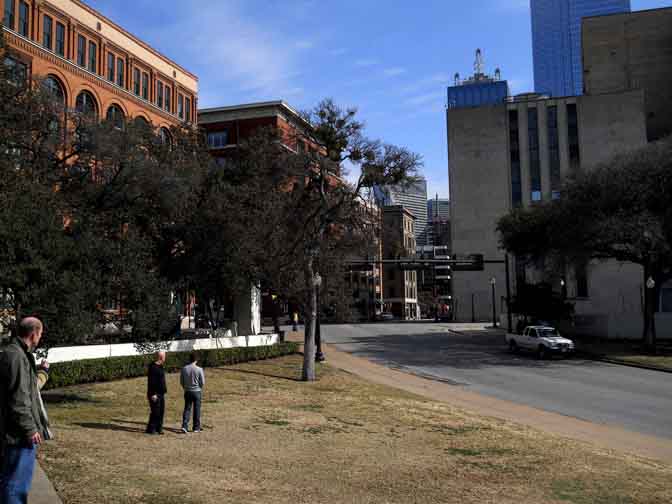
Even on the day we were there — it was Super Bowl Sunday — dozens of tourists roamed the plaza, taking pictures and forming their own opinions. One revelation that strikes all of us, who have seen countless films and still images, is how small Dealey Plaza is. Had there been a second shooter on the Grassy Knoll, he would have been firing from behind the fence, just 30 feet or so away from Abraham Zapruder. The last frame of Zapruder’s film actually shows the corner of that fence.
Still most Americans believe in the Grassy Knoll shooter and one of its most persistent proponents is Robert Groden, a former film technician, who took an early interest in conspiracy theories and was Oliver Stone’s technical consultant for “JFK.” In fact, on the day we were in Dealey Plaza, so was Groden. At the top of the steps that lead to the picket fence, Groden regularly sets up a card table and peddles his many books on the assassination. He even offers laminated photos for sale. And just in case tourists fail to initially see him and his wares, he posts a long yellow banner halfway up the Grassy Knoll that says:
“GRASSY KNOLL”
You have to see it to believe it.
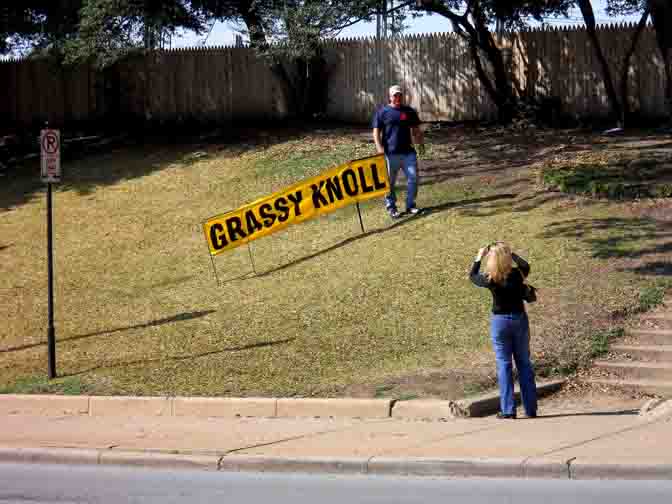
Though the City of Dallas has tried to shut him down, Groden has mostly prevailed, citing his right to be on public property. There’s a certain incongruity and surreal quality to the scene. For sure JFK’s death created a multi-million dollar industry that seems to show no sign of slowing down. But has any of it brought us closer to the truth?
And now, if the ultimate truth were to finally be revealed, if the government finally released the remaining documents that have been suppressed for 60 years, and if it didn’t match the preconceived notions of millions of Americans, would anybody believe it? And would anybody care?
*****
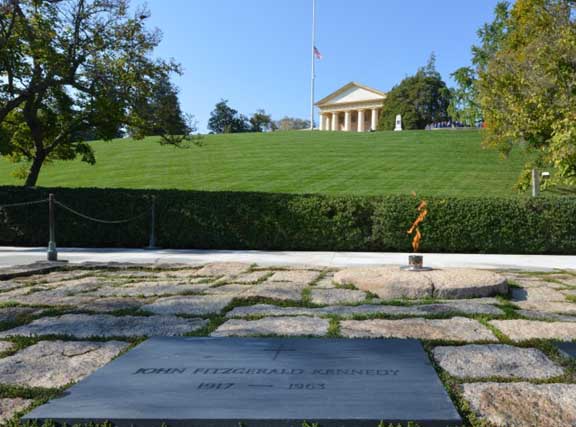
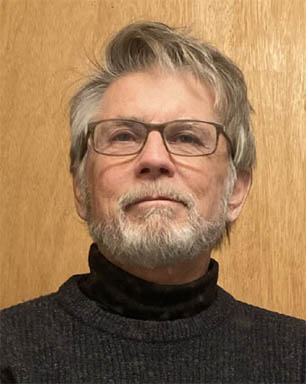
Jim Stiles is the publisher and editor of The Zephyr. Still “hopelessly clinging to the past since 1989.” Though he spent 40 years living in the canyon country of southeast Utah, Stiles now resides with two cats, Rambo & Rascal, on the Great Plains. Coldwater, Kansas is a tiny farm and ranch community, where there are no tourists.
He can be reached via facebook. Messenger, or by email: cczephyr@gmail.com
TO COMMENT ON THIS STORY, PLEASE SCROLL TO THE VERY BOTTOM OF THIS PAGE. I WOULD ESPECIALLY LIKE TO HEAR YOUR OWN RECOLLECTIONS OF 11.22.63,
IF YOU’RE OLD ENOUGH TO HAVE ONE…JS

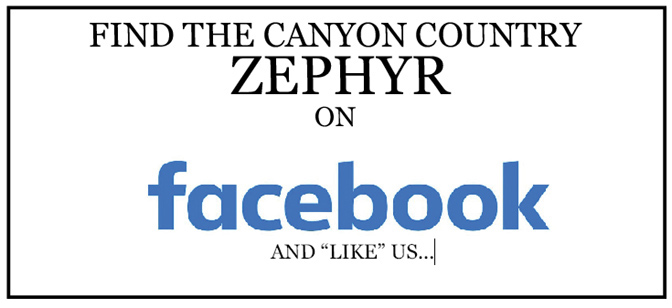
And I encourage you to “like” & “share” individual posts.
Why they can’t just leave the site alone is beyond me,
but that’s what Facebook likes to do.
ALSO NOTE: I post old photographs and stories from our 25 year old archives every day. Pictures from Herb Ringer, Edna Fridley, Charles Kreischer.. even a few old photos from my Dad. So if you want to stay caught up on our historic photo collections,
be sure to “follow” us on Facebook…Thanks…Jim
https://www.facebook.com/FansoftheCanyonCountryZephyr/
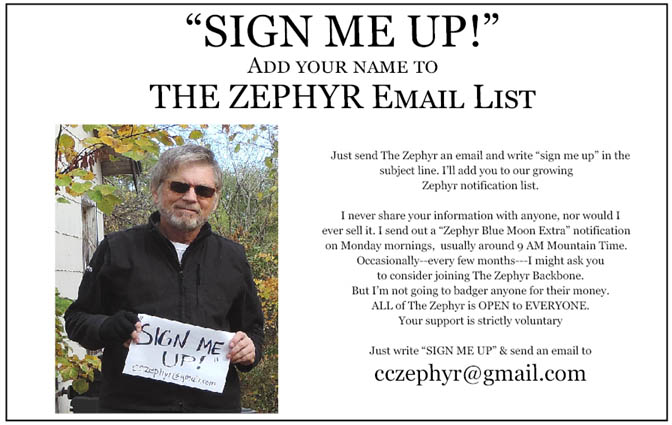
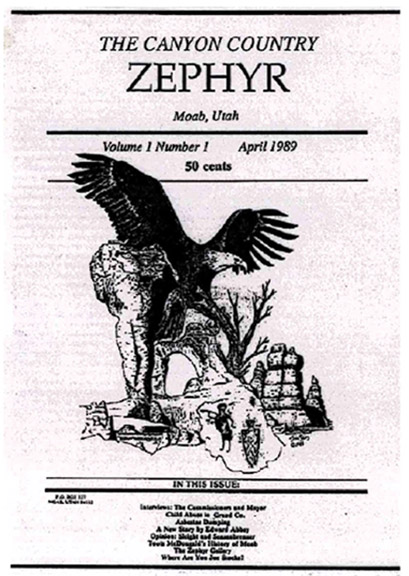
Signed copies
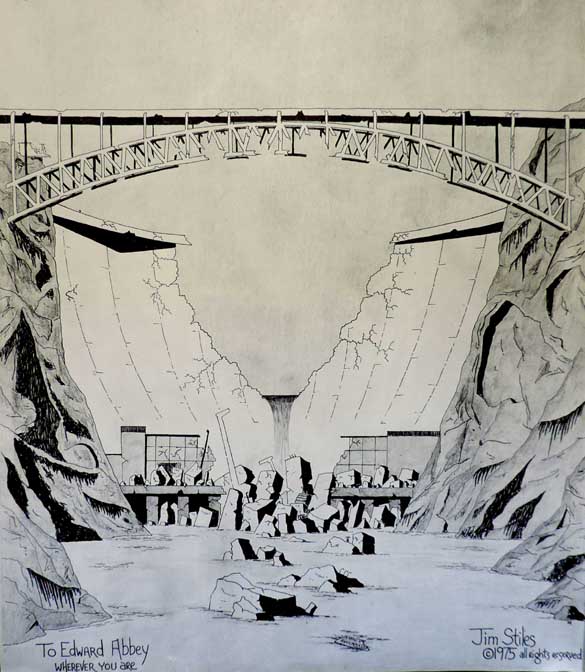
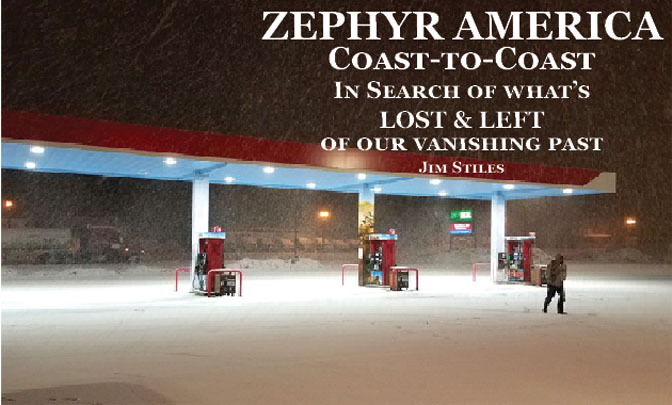
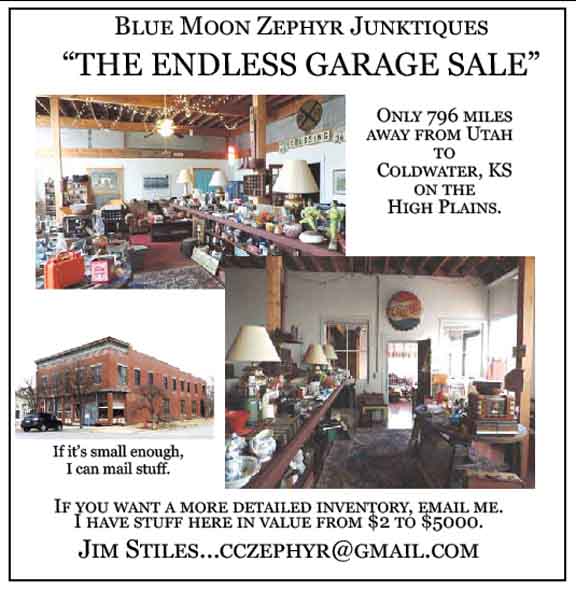
https://www.facebook.com/profile.php?id=100086441524150

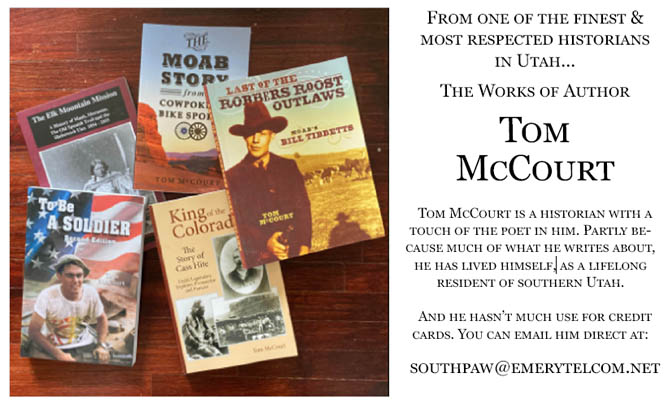
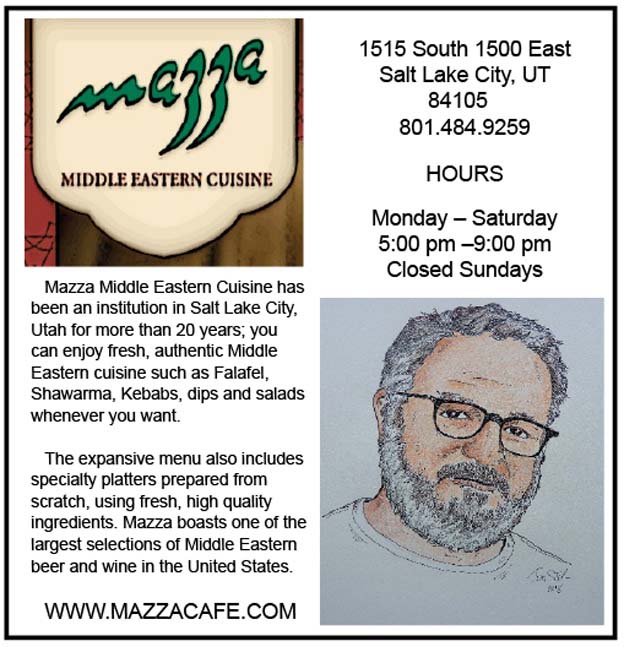
And check out this post about Mazza & our friend Ali Sabbah,
and the greatest of culinary honors:
https://www.saltlakemagazine.com/mazza-salt-lake-city/
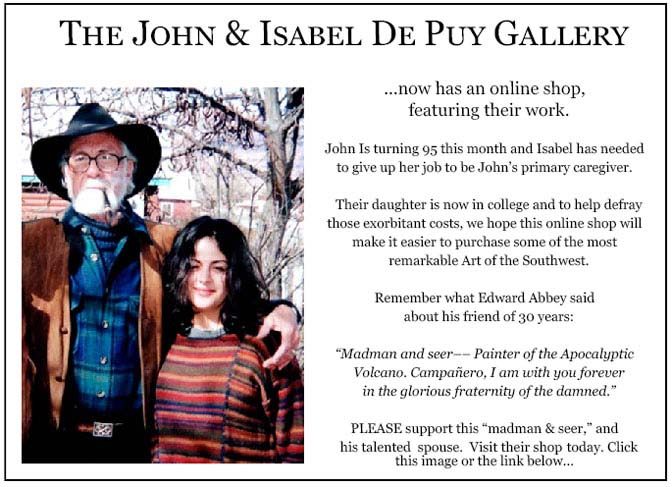
More than six years ago, The Zephyr, me & four other individuals were sued for defamation by the former Moab City Manager. Faced with mounting legal bills, my dear friends John and Isabel De Puy donated one of John’s paintings to be auctioned.
ALL the proceeds went to our defense.
Thanks to them, our bills were almost completely covered.
Now I’d like to return the favor. Check out the link below and their online shop… JS
https://www.depuygallery.com/

https://www.canyoncountryzephyr.com/
And once more, if you would like to comment on this story, or share your own memories of November 22, 1963, I’d like to hear other stories from Zephyr readers who still remember…Jim Stiles

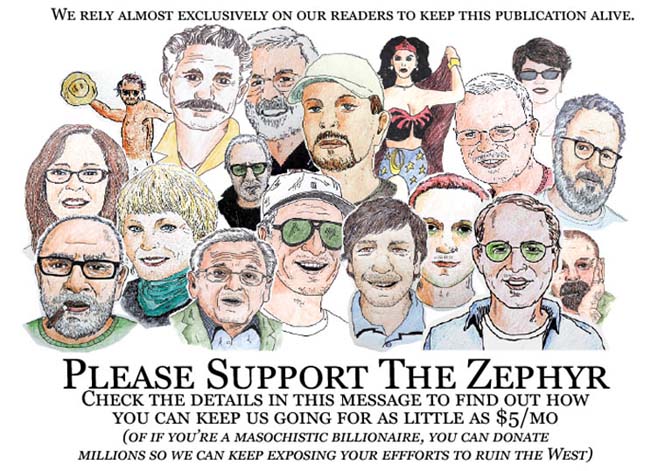
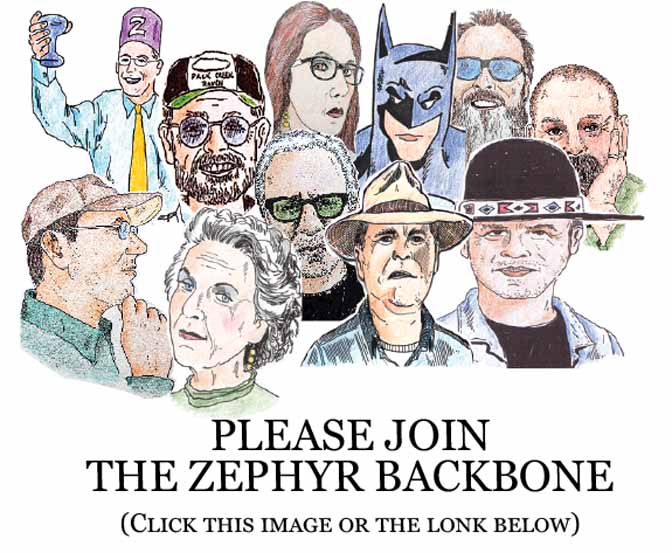
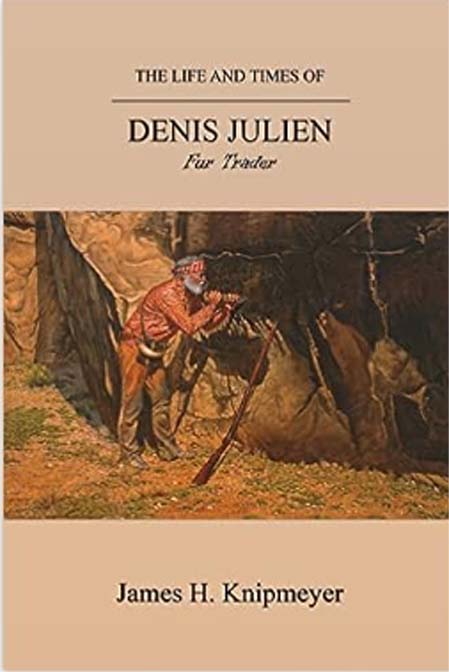
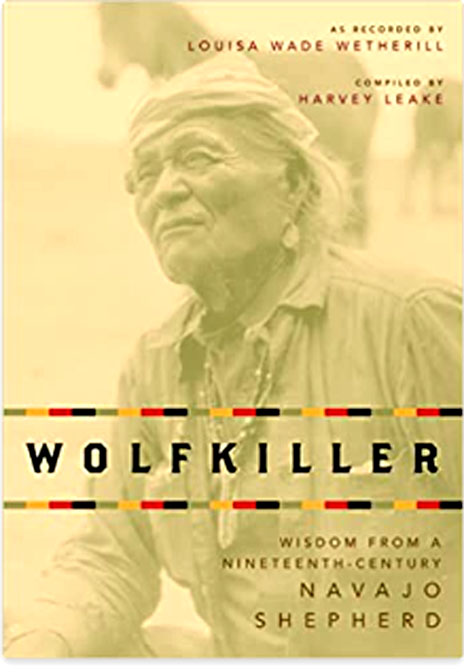
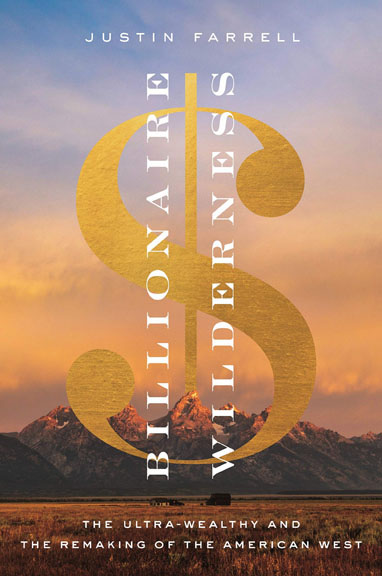
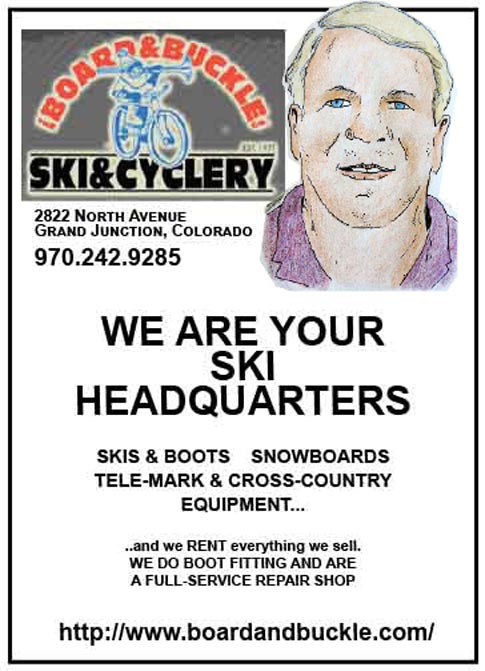
I remember that day. I was in sixth grade at a Catholic school in my hometown. The school was small, so there were two grades in each room. The nun was teaching something to the fifth-grade side of the room, when the principal came to the door and motioned for her to come out into the hall. A few minutes later she came back in and said: “Boys and girls, President Kennedy has been shot.” An audible gasp came from everyone in there. School was cancelled. We all trooped over to the church next door to say a Rosary and to pray for him to survive. Of course he didn’t. One really poignant moment I remember was, after he had been announced as deceased, a couple of the seventh- or eighth-graders were lowering the American Flag to half-staff. Thank you, Jim, for your beautifully-written recounting of your experience. I too wonder: Can America ever recover from this incident and all the countless others that have occurred since then?
Thanks. I had many Roman Catholic friends and remember how devastated they were. We all were, but it was really more personal, since JFK was the first Catholic elected President.
An excellent over view Jim. As a nine year old I felt cognizant of the positive momentum of Kennedy’s presidency. By today’s standards. He was a moderate. He was helping to create the peace corp, the green berets and gave us the moon challenge. He was a war hero in a sea of WWII vets. All my life I have thought at times of his job unfinished. His words of encouragement, “ask not” spoke to our national potential. Even today when I know of his seedier, human side I hold an admiration for him and his message. Every Thanksgiving I relive the national loss. I still feel as though a promising family member was cut down prematurely by a drunken driver that also died in the crash. I respect those that would disagree with me but personally, I sense that in certain ways we experienced a high water mark and then the moment was stolen. Many lessons to be learned from that moment in time.
Just last week I saw an interview with Clint Hill, the agent who made the desperate attempt to reach JFK Z before the fatal shot. He’s 91 now and he said it was “the day America lost its innocence.”
I was 7 in November 1963. My only memory is watching the procession to (or from) the Capitol on our black and white TV.
BTW, the Wall Street Journal recently published a piece By Timothy Naftali about how the secrecy, cover-ups, and select inner circles of the Kennedy administration made it easy for many people to embrace conspiracies about the assassination.
I was in a junior high social studies class in my hometown of Santa Barbara, Calif. We didn’t have intercoms in “the portables,” so class was interrupted by a secretary from the office. After a whispered few sentences with our teacher, both women burst into tears. The teacher then announced, “President Kennedy has been shot.”
The adults didn’t seem to know what to do. Eventually, they gathered all 2,000 or so of us students on the ballfield, where we sat for what seemed like hours. Eventually, they told us to “Go home.” We looked at each other in bewilderment–how? No busses, no parents picking up, just hundreds of confused kids walking along local roads My house was a bit of a hike, five miles away at the top of Laurel Canyon. Along the way, I saw several drivers pulled over to the side of the road, sobbing. The foundation was already starting to shift.
It might have not been immediately apparent, but the world changed that day and has not changed back. A pivot point was reached that left a generation suspicious of the government, its wars against whatever subhuman opponent had won the Enemy of the Week contest, and world events in general.
I still feel a major dose of skepticism is appropriate when dealing with the government, but I wonder, are we capable any longer of working together as a community? I doubt the current population could pull things together enough to win a World War II. Shucks, we can’t even manage to pass a yearly budget without shutdown threats. And we certainly don’t lack for potentially civilization-shattering issues which will require WW II-type responses.
I may just be old and tired, but it appears the Clever Ape experiment is not working out.
Yes. I agree. I’ve never seen the country so polarized in such an utterly inflexible way. We both lived through the 60s. At the time they still called 1968 “the year everything went wrong.” Sometimes that period from 1963 to 1968 feels like now. Starting in 2020…will 2024 feel like 1968?
Jim,thank you for your recollection,I think you did a similar thing for the 50th anniversary and I responded then as well. I was 7 yrs old then and my family were Catholic New England Irish Democrats living in Fort Worth where my Dad had gotten a job as an Air traffic controller after serving in the Army. I was a precocious kid who was obsessed with JFK and all the US Presidents. Where most small boys in Texas played football and GI Joe I had small statues of all the Presidents,a 3ft model of the US Capitol and was reading youth version biographies of all the Presidents. Just based on the plastic statues my favorite President was Zachary Taylor because he was wearing his military uniform and he looked cool. My Dad knew JFK’s visit was a rare opportunity and he pulled some strings and he and I were able to be part of a group of people welcoming Air Force 1 at Carswell AFB in Fort Worth at 11PM on the night of the 21st. I think there were about 20 of us cordoned off and we watched the plane land and I remember the excitement of finally seeing JFK and Jackie walk down the stairway of the plane waving towards us. At the bottom they paused,talking to some people and then got into the cars that would take them to downtown Fort Worth where they would spend the night before going to Dallas. As soon as they left,lights were turned off and it was quite dark and we worked our way back to the car and home. The next day I went to school(St. George’s Catholic School) with stories to tell and it was a normal school day until I noticed that the school buses to take us home showed up two hours early. The intercom cackled on and the principal told us that the President had been shot and that school would be letting out early. I arrived home to see both of my parents crying and the news that JFK had died. It was the only time in my life I saw them crying which added to the imprint of the day. Even though Fort Worth is only 30 miles from Dallas we never went to Dallas again in my childhood,it was too tainted and this was shared by many of our neighbors as well. It is hard to imagine having a clear memory of something from 60 years ago and the only other memory from then as vivid was 4 months later when the Beatles were on the Ed Sullivan show which for me also helped in the moving on process.
Jim, I got up early this Monday 20 November 2023 morning with a list of things to accomplish today. Now it is nearly 10 am and I have been carried away from the present to the past by your article. I don’t know of anyone who does a better job of capturing the details and feelings of events like you do. I was a graduate student at Purdue University that morning when I walked into an office I shared with Sudat Suwatanapo (spelling ?). He was from Viet Nam ? and my first thought was that he had misunderstood the news. In a few short minutes I found out that he knew what he was talking about. I was dismayed and very sad to hear about JFK’s death. Later, the next day or so, I was picking up my shoes from a repair shop run by an old gentleman. (Do you remember when we had our shoes resoled and tires retreaded?) This old repairman handed me my shoes and referring to President Kennedy said, “Isn’t that just like a young man, We old guys come to an intersection look both ways then look both ways again then cross the street. A young man comes to the same intersection and just runs across without hardly a glance at the traffic.” I think he was referring to the open limousine.
Thanks Kay. I miss you guys. Give my best to Patsy.
As an incurable conspiracy theorist, I still believe the CIA was culpable in JFK’s assassination. Following the bay of Pigs fiasco, Kennedy expressed deep frustration with the CIA and did not trust its highest operatives. He is reported to have said he would “splinter the CIA in a thousand pieces and scatter it to the winds.” Makes one think…
I was a UC Berkeley student at the time who had watched Walter Kronkite announce JFK’s death at 11am PSTime with many others on a B&W TV in the Student Union. We were stunned, some began to cry as we filed out afterward. A Peace Corps recruiting table was at the bottom of the steps in Sproul Plaza, for those that know the University of California, Berkeley campus, where I immediately volunteered for the Peace Corps. I suddenly knew what I wanted to do: answer Kennedy’s call that he made during his inauguration speech, “Ask not what your country can do for you, ask what you can do for your country.” I began my life of public service. It was my way of keeping his dream of peace alive.
Great comment Harlan. Thank you.
I remember the day that JFK was assassinated, like it was yesterday. I was in the 4th grade at Southeast elementary in Moab, Utah. I was a lunch when I found out. A sixth grade girl came in crying. I felt sorry for her. In a few minutes I noticed all the sixth grade girls were entering the lunchroom crying. I was shocked at the news. When I arrived home after school, my mother was crying as she was sweeping the floor. “But, Mama,” I said, “you voted for Nixon.”
“That doesn’t matter,” she replied, “my President was shot today.” I also remember her listening to the radio when his funeral was happening. My memory is that it was all in Latin.
Fast forward 20 years. I was living in Carrollton, Texas a suburb just north of Dallas. We had already visited the sixth floor and Dealey Plaza. On the 20th anniversary of his death, WFAA replayed all the footage and many interviews, in commemoration of that day. I stayed up late into the night watching it while I sewed on a dress for my daughter. It was a sad time for Dallas and a very sad time for our nation.
‘Back and to the left’. The Zapruder film of Kennedy’s head exploding to the rear of the limo is all you need to see to know there were multiple shooters.
The Warren Commission was a, laughable, farce which kept the gullible masses happy for a while until it all blew over and whoever could get on with whatever it was they wanted to do. Magic bullet BS. Yeah, whatever.
People say America lost its innocence on that day in November 1963. Well, this also is rubbish. The America of 1963 was founded on genocide, rape, murder and theft. The British Empire had been doing the same for a couple of centuries before you Yanks took it to another level.
I was a month old when Kennedy took a shot to the head from front right of him so don’t remember it in detail. We didn’t even have a TV until 1971 and, even then, it was a second-hand, grainy black and white job with three channels, none of which were showing JFK’s bonce exploding backwards in a mist of blood and brain matter.
So who wanted him dead? It would be easier to ask who didn’t? My money is on your government (the CIA) and some other factions. War is good for the economy, peace not so. We’re currently seeing the same thing play out in Ukraine and the Middle East.
Can I just recommend a youtube video to y’all? It’s fairly depressing, probably not entirely based in fact, but is nonetheless thought provoking and well worth watching.
It’s titled ‘JFK to 9/11: Everything Is a Rich Man’s Trick’. I’ll post the link but if Jim doesn’t DO links you can look it up in YouTube. Scary stuff.
https://www.youtube.com/watch?v=niTwvtokYf0
I’ve got to agree with Marjorie &”bob”, the assassination WAS a coup, probably engineered by the CIA w/the assistance of the Mafia and to the joy of the military Chiefs of Staff who were pissed off @ Kenedy for not supporting the Bay of Pigs invasion and his plan to abandon the US incursion into Vietnam. Allan Dullas, director of the CIA, was on the Warren Commission just to make sure the “investigation” went as planned and no “serious” people questioned the official conclusion…
I was sleeping off a bender (developed, the previous night, in several nearby Monterey taverns) under a desk in the storage room attached to the Fort Ord Army recruit reception facility, when a coworker rudely awakened me with the news. I’m ashamed to admit that my first hazy thought was that now the military powers-that-be will have an excuse to have us all march around in full dress uniforms for the next week or so. It didn’t happen, phew! The reprieve from marching gave me time to grieve & begin contemplating the whole business & eventually settle on the aforementioned conspiracy theory.
My dad was the county chairman of the San Luis Obispo (CA) Democratic party (the 3rd or 4th most heavily Republican county in CA and one of the 5 or 10 actual Democrats in the county during the 1960 election and I did my share, @ 15 yrs. of age, helping Pop campaign, door-to-door, for the president). On top of that, the whole family was heavy duty Catholic, and that added considerably to our distress.
Pop, besides teaching economics & finance @ Cal Polly College, was a Pearl Harbor survivor, a B-29 bombardier/navigator w/26 visits to Japan under his belt, and, at the time of the assassination, the Company Commander of the Signal Corp Army Reserve unit @ Camp San Luis Obispo. The Signal Corp is the army’s communication branch and officers in that outfit had access to a lot of info not shared with the general public. Although we didn’t spend much time discussing the possibility of a coup, I found out years later that he pretty much agreed with me on the subject.
Thanks, Jim, for your fine writing on your take on the assassination and bringing it to the attention of the youngsters in your following who may well have been denied an education in the history of our country. And thanks for the opportunity to disagree with you, finally, on something.
Jim, I was in first grade at Elliot elementary school in Artesia, California. I remember the overhead speaker first started to play a recording of the National Anthem..My classmates knew something was wrong as our teacher Mrs. Adams strated to cry. Somehow she had gained information of what had just happened. My 1st grade classmates sat at our desks not knowing what had just happened and what we were supposed to do. Our teacher Mrs Adams then got very angry with the entire class because we did not know to stand and face the flag when the National Anthem was being played. She was crying uncontrollably and at the same time was irate that her 1st grade students hadn’t been toold what to do when the National Anthem was being played. I can remember it like it was yesterday.. Reading this story tonight brought me to tears. Don Oleson
Good morning Jim. I’m 24 years out of Moab. I wish you well.
I was a 16 year old Army brat in Mannheim Germany on that day, evening to us. I was on my way to a friend’s party when I heard the news. I wasn’t sure I wanted to go but realized I needed to be with someone(s), people that would share my grief.
As I walked to the party I heard a loud adult party going on in one of the post’s apartment buildings. I went up to it and knocked on the door. A man answered. I asked if he had heard. It was like his response, “so what”. I left and and went on to the party. We comforted each other.
The only TV I watched during my entire HS career in Germany was the Kennedy funeral. It wasn’t scripted. Time stood still.
We had a special assembly at school where our guidance counselor spoke and read from John Donne’s “For Whom the Bell Tolls”.
I will never forget those words. “It tolls for you”.
Jim, your moving account of that day and the days following brought me to tears, partly because of the JFK Assassination and the sadness following, and partly because of the blow it seemed to strike at America. I happened to see the first TV reports before the sad news from Parkland Hospital. Walter Cronkite appeared to cry on national TV as he reported the tragedy. Like others who’ve commented, I then believed it changed America…stole its innocence…and overturned the voter’s choice. For many years I was cynical and suspicious of the CIA, etc. I often thought to myself that all of the various conspiracy theories were encouraged as a way to hide the guilty persons responsible. Jim Garrison brought Clay Shaw, a CIA chief, to trial but a jury freed him. The mysterious death of Dorothy Kilgallen, etc., and the theories about the military/industrial complex and the Vietnam War. I was only eighteen then but in the years since I’ve learned that there are profits in pushing conspiracies. Recent years have made that pretty obvious. I’m less certain today that JFK’s assassination was covered up by the Warren Report, or LBJ, whom I distrusted. Jack Kennedy was a WW War ll hero and had personality, intelligence, and a sense of humor, and it was hard to not admire him. We’ve suffered assassinations before (Lincoln, Garfield, and McKinley) but JFK’s struck those of us alive far harder, he was like a leader and a friend. With the attempted Reagan assassination I thought, “Oh no, not again”!
Thanks again for commemorating a day that we’ll never forget!
I was 7, in Fruita’s Shelledy Elem. I don’t believe school let out early. Thanksgiving was always a big deal. Family we saw only once a year would travel from Denver. I don’t recall if the celebration was the same as the year before or the years afterward. I remember watching all the doings on TV. My dad railed daily about JFK as well but I don’t know why he didn’t like him other than he was a Democrat. (?) “We all had dads.”
Great writing as always Jim, thank you for all your efforts here. I hope you have a happy Thanksgiving.
Another great story and tribute Stiles. What a horrible day and horrible event. I was sitting in a 4th grade class in Jacksonville, Arkansas when the intercom came on telling us what had happened. Everyone, even at that age, was stunned and crying and we were excused. We all lost so much that day. Nothing has ever been the same. I think 500 years from now, historians will look back at this event and identify it as one of the key turning points in US and world history, and not a good turning point.